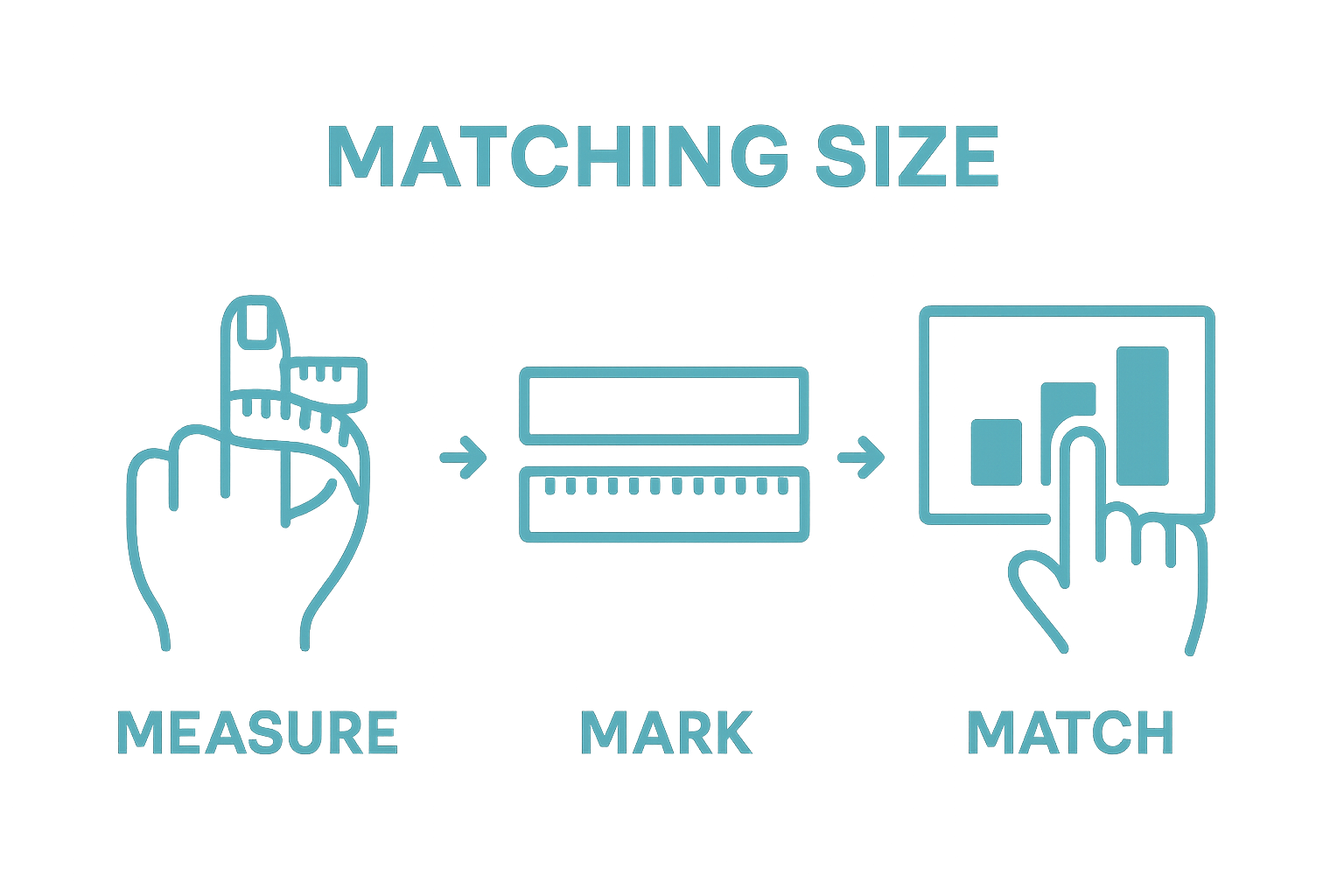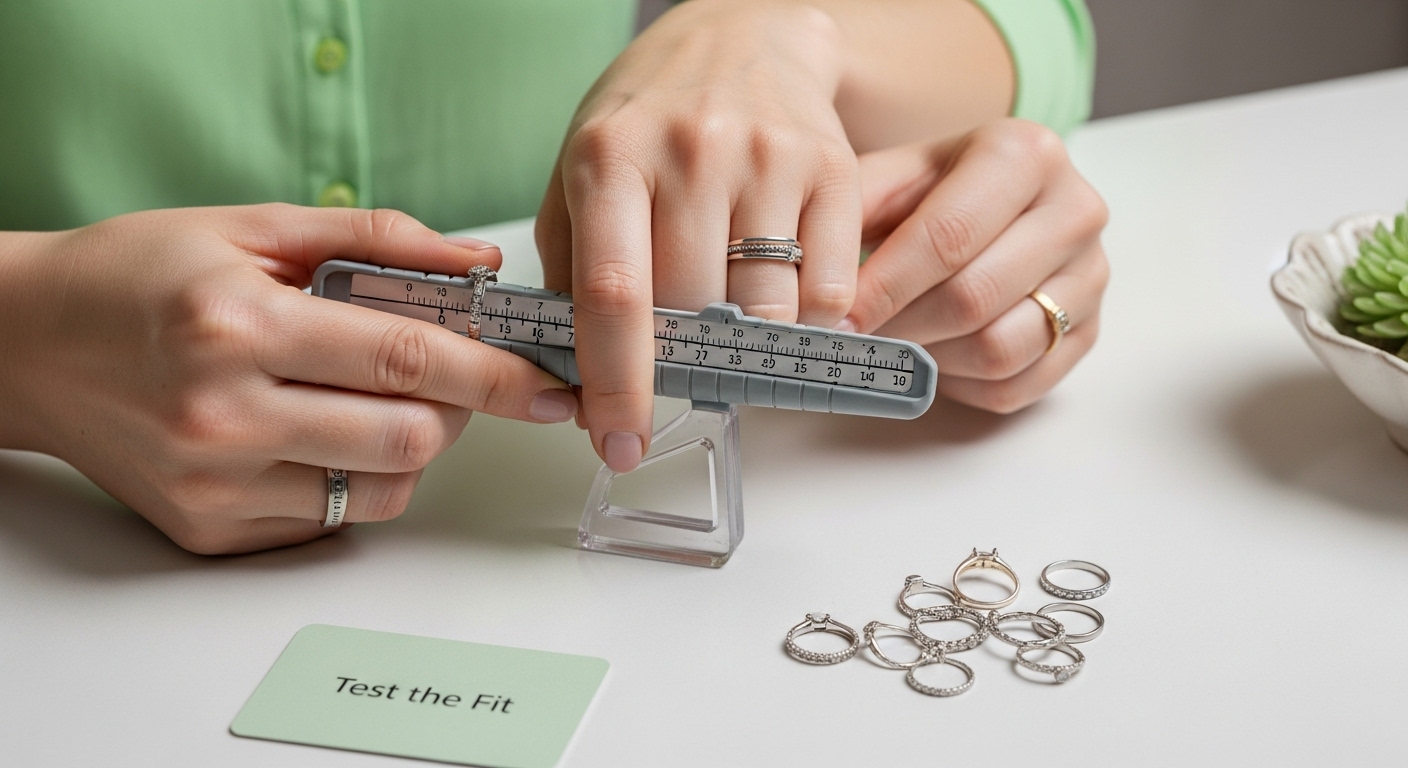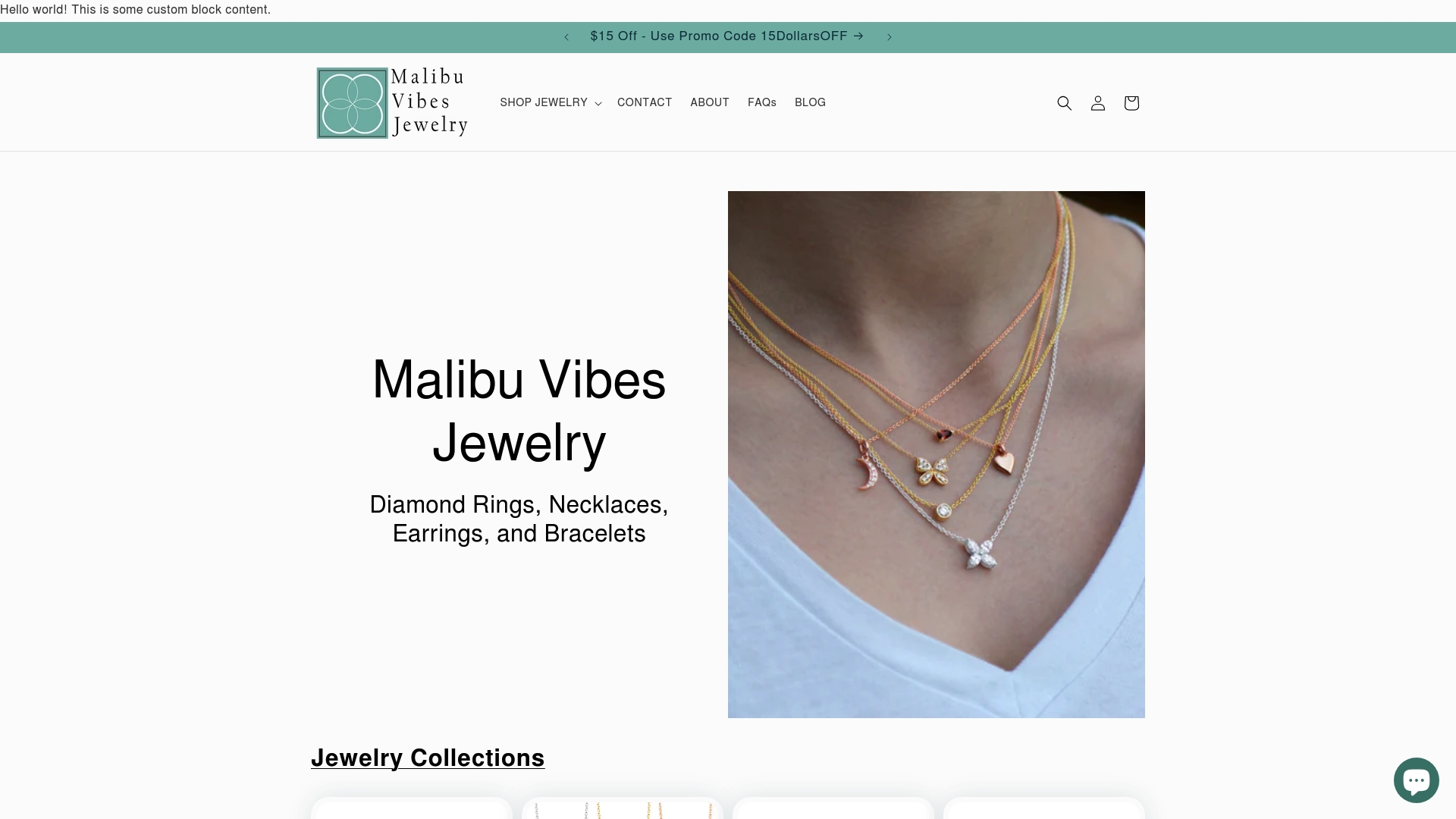Finding the perfect ring size at home might sound tricky, but it is more achievable than most people expect. Did you know that even a difference of just half a millimeter can affect how a ring feels and fits throughout the day? Most surprising of all, slight changes in your finger’s temperature or hydration can cause your ring size to fluctuate more than you think, so the ‘right’ fit is about far more than just one quick measurement.
Table of Contents
- Step 1: Gather Your Tools And Materials
- Step 2: Measure Your Finger Size Accurately
- Step 3: Determine Your Ring Size Using A Chart
- Step 4: Test The Fit Of Sizes With A Sample Ring
- Step 5: Adjust Size As Needed And Finalize Your Choice
Quick Summary
| Key Point | Explanation |
|---|---|
| 1. Gather proper measuring tools | Use flexible tape, string, or a printable sizer to ensure accurate measurements. |
| 2. Measure fingers in ideal conditions | Avoid temperature extremes and exercise when measuring to get a reliable size. |
| 3. Verify measurements multiple times | Repeat measurements to confirm accuracy, ensuring ideal fit and comfort. |
| 4. Consult a ring size chart | Use the circumference measurement in millimeters to find your ring size in the appropriate system. |
| 5. Test fit with sample rings | Try on similar-sized rings to confirm comfort and fit before finalizing your selection. |
Step 1: Gather Your Tools and Materials
Accurately sizing a ring at home requires precision and the right set of tools. Before diving into the measurement process, you will need to collect several essential items that will help you determine your ring size with confidence. According to the Gemological Institute of America, proper tools are critical for obtaining a reliable measurement.
The primary tools you will need include a flexible measuring tape or string, a ruler with millimeter markings, and a piece of paper. Alternatively, you can use a printable ring sizer, which many jewelry websites offer as a free downloadable resource. Comfort and accuracy are key when measuring your ring size, so choose tools that allow you to measure without causing discomfort or distortion.
To prepare for measuring, ensure you are in a comfortable environment with good lighting and a flat surface. Your fingers can change size throughout the day due to temperature, activity level, and hydration, so it is best to measure when your hands are at a normal temperature and have not been recently exposed to extreme heat or cold. Avoid measuring immediately after exercise or during very hot or cold weather, as these conditions can temporarily alter your finger’s size.
If you do not have a specialized ring sizer, you can create a makeshift measuring tool using a strip of paper or a soft string. Wrap the material around the base of the finger you intend to wear the ring, marking the point where the material overlaps. Then, use a ruler to measure the length of the marked section in millimeters. This method provides a simple yet effective way to determine your ring size at home.
Verify your measurement by checking the following criteria:
- The measuring material should fit snugly but not tightly around your finger
- You should be able to slide the material over your knuckle with slight resistance
- The measurement should feel comfortable and not constrict blood flow
By carefully gathering your tools and following these preparatory steps, you will set the foundation for an accurate ring sizing process.
Below is a handy table summarizing essential tools and materials required for accurate ring sizing at home, along with their main purposes and notes on their use.
| Tool/Material | Purpose | Notes |
|---|---|---|
| Flexible measuring tape | Measure finger circumference | Should be soft to ensure comfort and accuracy |
| String or paper strip | Alternative for finger measurement | Can be marked and then measured with a ruler |
| Ruler with millimeter marks | Determine length of string/paper | Millimeter precision is recommended |
| Printable ring sizer | Provides a template for direct sizing | Often available on jewelry websites |
| Good lighting | Ensures clear visibility during measurement | Prevents errors or misreading |
| Flat surface | Used for marking and measuring materials | Aids stability during preparation |
Step 2: Measure Your Finger Size Accurately
With your tools prepared, you are now ready to determine your precise ring size through careful measurement techniques. According to the FAMU-FSU College of Engineering, accuracy depends on choosing the right measurement method and understanding subtle nuances in finger sizing.
Choosing the correct finger for measurement is crucial. If you plan to wear the ring on a specific finger, measure that exact finger, as sizes can vary slightly between different digits. For engagement or wedding rings, measure the ring finger on your dominant hand, which typically provides the most consistent sizing.
To begin measuring, wrap your flexible measuring tape or paper strip around the base of your chosen finger. Ensure the material sits comfortably without pulling or being too loose. The measurement should feel snug but not constricting. If using a paper strip, mark where the material overlaps, then carefully measure the length using a ruler with millimeter markings.
Repeat the measurement process three times to confirm consistency.
Variations can occur due to factors like temperature, time of day, or slight hand movements. Pro tip: measure your fingers at room temperature and avoid measuring immediately after physical activity or when your hands are cold or swollen.
If you want more insights into precise jewelry measurements, check out our guide on bracelet sizing which offers complementary tips for accessory fitting.
Verify your measurements by checking these key indicators:
- The measurement feels comfortable and allows slight movement
- You can easily slide the ring over your knuckle
- There is no pinching or excessive looseness
Remember that ring sizes can fluctuate slightly throughout the day, so it is recommended to measure multiple times and choose a size that feels consistently comfortable. By following these detailed steps, you will be well on your way to finding the perfect ring fit.

Step 3: Determine Your Ring Size Using a Chart
Translating your finger measurements into an accurate ring size requires understanding standard sizing charts and their nuanced details. According to the Gemological Institute of America, selecting the right size involves more than simply matching numbers.
Ring size charts typically use two primary measurement systems: the US numerical scale and the inside circumference measurement in millimeters. If you measured your finger using a paper strip or flexible tape, you will need to convert your millimeter measurement to the corresponding ring size. Most standard US ring sizes range from 3 to 13, with half sizes available for more precise fitting.
To match your measurement, locate a reputable ring size chart and carefully align your finger’s circumference with the corresponding size. Pay close attention to the width of the chart’s sizing guidelines, as wider bands might require a slightly larger size to ensure comfortable wear. Some charts include additional international sizing references, which can be helpful if you are purchasing rings from different regions.
If you are shopping for an eternity ring or special occasion band, remember that certain ring styles might have unique sizing considerations. Wider bands or intricate designs can affect how the ring fits, potentially necessitating a quarter or half size adjustment.
Verify your ring size selection by checking these critical factors:
- The measured size feels comfortable when simulated
- There is minimal gap between the ring and your finger
- The ring can slide over your knuckle without excessive struggle
For the most accurate results, consider comparing your home measurements with a professional jeweler’s sizing. While home methods provide excellent initial guidance, professional tools can offer ultimate precision. Some jewelry stores provide complimentary sizing services, which can serve as a final confirmation of your measurements.
Remember that finger sizes can fluctuate due to temperature, hydration, and other factors. If you are between sizes, it is generally recommended to choose the slightly larger size for maximum comfort and ease of wear.
Step 4: Test the Fit of Sizes with a Sample Ring
After meticulously measuring and consulting sizing charts, the final step in ensuring a perfect ring fit involves practical testing using sample rings or adjustable sizing tools. Confirming your measurements through hands-on evaluation provides the ultimate validation of your sizing calculations.
If possible, borrow rings from friends or family members in sizes close to your measured dimension. This approach allows you to physically experience how different sizes feel on your finger. Pay attention to how easily the sample ring slides over your knuckle and whether it sits comfortably at the base of your finger without spinning or feeling too tight.
Ring movement and comfort are critical indicators of proper sizing. A well-fitted ring should require a gentle push to pass over your knuckle but then settle snugly at the base of your finger. It should not leave significant indentations or feel like it might slip off unexpectedly. If you are considering a stunning infinity ring design, remember that intricate designs might slightly impact how the ring sits.
For those without access to sample rings, adjustable ring sizers available at most craft stores or online provide an excellent alternative. These tools typically feature multiple interconnected metal or plastic rings in various sizes, allowing you to systematically test different dimensions. Experiment with sizes immediately adjacent to your initial measurement, as sometimes a quarter or half size can make a significant difference in comfort.
Verify your ring size fit by checking these essential criteria:
- The ring sits comfortably without sliding or rotating excessively
- You can move your finger without feeling constricted
- Removing the ring requires a gentle, smooth motion over the knuckle
- There are no visible marks or indentations after wearing the ring
Consider testing your ring size at different times of day, as finger circumference can fluctuate with temperature, activity, and hydration levels. If you consistently find yourself between sizes, jewelry experts recommend choosing the slightly larger size for maximum comfort and ease of wear.

Step 5: Adjust Size as Needed and Finalize Your Choice
After carefully measuring and testing your ring size, the final step involves making precise adjustments and confidently selecting the perfect fit. Flexibility is key in ensuring ultimate ring comfort, as slight variations can significantly impact your wearing experience.
If your initial measurements reveal that you are between two sizes, consider the specific characteristics of the ring you plan to purchase. Different ring styles, such as wide bands or intricate designs, might require slight size modifications. Wider rings typically need a slightly larger size to accommodate the additional metal circumference around your finger. For instance, if you measure as a size 6 with a narrow band, you might want to choose a 6.5 for a broader ring design.
Temperature and physical conditions play a crucial role in ring sizing. Fingers can change size throughout the day due to factors like humidity, temperature, physical activity, and even diet. Recommended best practices suggest measuring your finger at different times to establish a consistent baseline. If you notice significant variations, opt for the size that feels most comfortable during your most typical daily conditions.
For those interested in exploring unique ring designs like our channel set diamond band, remember that professional jewelers can provide final sizing adjustments. Many jewelry stores offer complimentary resizing services within a specific timeframe after purchase, providing an additional safety net for your investment.
Verify your final ring size selection by considering these critical factors:
- The ring feels comfortable during extended wear
- There is minimal spinning or sliding on your finger
- You can easily remove the ring over your knuckle
- The ring maintains a consistent fit throughout different times of day
Ultimately, choosing the right ring size is a nuanced process that combines precise measurement, practical testing, and personal comfort. Trust your own sensation and do not hesitate to seek professional guidance if you remain uncertain. A perfectly sized ring should feel like a natural extension of your hand, seamlessly blending comfort with style.
Use this table as a convenient final checklist to verify all comfort and fit criteria after measuring and testing your ring size, ensuring your selection is the right fit for daily wear.
| Verification Step | What to Check For |
|---|---|
| Comfortable fit during extended wear | Ring does not pinch or feel too loose |
| Minimal spinning or sliding | Stays in place, not constantly rotating |
| Easy removal over the knuckle | Comes off smoothly, no excessive struggle |
| Consistent fit throughout the day | Feels comfortable in various conditions |
| No visible marks or indentations after removal | Does not leave deep impressions on skin |
Find Your Perfect Ring Fit with Malibu Vibes Jewelry
You have just learned how to avoid the frustration of poorly fitting rings by following detailed measurement steps at home. When you invest time in accurate sizing, you ensure that every piece you wear feels as good as it looks. At Malibu Vibes Jewelry, our expertly crafted collection of Diamond & Gold Rings for Women lets you put your newfound knowledge to use immediately, eliminating guesswork and disappointment. Experience the satisfaction and confidence that only come from pieces made to fit you perfectly.

Discover our curated range of quality rings and make your selection with complete confidence. Our site gives you access to every detail you need, from sizing guidance to stunning imagery and authenticate precious materials. Explore the entire lineup at Malibu Vibes Jewelry or dive in and find a signature look with our 14k Diamond Stacking Ring selection. Start your search now and let your perfectly sized ring become your new favorite accessory.
Frequently Asked Questions
How can I measure my ring size at home?
To measure your ring size at home, you will need a flexible measuring tape or a strip of paper. Wrap it around the base of your finger, mark where it overlaps, and then use a ruler to measure the length in millimeters. Alternatively, you can use an online printable ring sizer.
What should I consider when measuring my ring size?
When measuring your ring size, ensure that your finger is at a normal temperature, avoid measuring after exercise or in extreme weather, and select the finger you plan to wear the ring on. Measure multiple times for consistency.
How do ring sizes differ by design?
Different ring designs can fit differently, especially wider bands or intricate styles. Typically, wider rings require a slightly larger size for comfort, sometimes a quarter or half size up from your standard measurement.
What if I am between two ring sizes?
If you find yourself between two sizes, it’s generally best to choose the larger size to ensure comfort, especially if the ring is wide or intricate. Consider how the ring fits in various conditions, as your finger size can fluctuate throughout the day.



